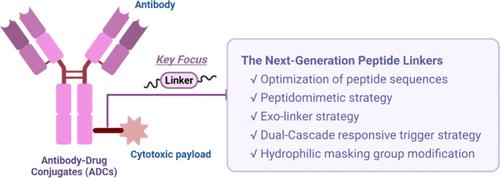Recent Advances in Peptide Linkers for Antibody-Drug Conjugates
IF 6.8
1区 医学
Q1 CHEMISTRY, MEDICINAL
引用次数: 0
Abstract
Antibody-drug conjugates (ADCs) are at the forefront of next-generation targeted cancer therapies, owing to their high specificity and potent cytotoxicity. The linker within ADCs plays a critical role in balancing efficacy and safety. Cleavable peptide linkers, dominating clinical-stage ADC design due to their capacity for selective drug release, nonetheless face challenges such as structural homogeneity, limited mouse plasma stability, and insufficient hydrophobicity improvement. Consequently, developing novel peptide linkers with enhanced stability, selectivity, and physicochemical properties is a key research focus. Here, by highlighting the cleavable peptide linkers used in clinical-stage ADCs and summarizing novel strategies in next-generation linker designs, we provide a timely overview of advances in peptide linkers, covering new peptide or peptidomimetic sequences, exolinker strategies, dual-cascade triggering mechanisms, and hydrophilic modifications. This review aims to offer a theoretical foundation and research insights for innovative linker design, thereby advancing next-generation ADCs to meet the growing demand for precision therapies.

抗体-药物偶联肽连接物的研究进展
由于其高特异性和强细胞毒性,抗体-药物偶联物(adc)处于下一代靶向癌症治疗的前沿。adc内的连接体在平衡疗效和安全性方面起着关键作用。由于其选择性药物释放的能力,可切割肽连接物在临床阶段ADC设计中占据主导地位,然而面临着结构同质性、小鼠血浆稳定性有限和疏水性改善不足等挑战。因此,开发具有增强稳定性、选择性和物理化学性质的新型肽连接物是一个关键的研究重点。在这里,通过重点介绍临床阶段adc中使用的可切割肽连接物,并总结下一代连接物设计的新策略,我们及时概述了肽连接物的进展,包括新的肽或拟肽序列、外链连接物策略、双级联触发机制和亲水性修饰。本综述旨在为创新的连接器设计提供理论基础和研究见解,从而推进下一代adc以满足日益增长的精确治疗需求。
本文章由计算机程序翻译,如有差异,请以英文原文为准。
求助全文
约1分钟内获得全文
求助全文
来源期刊

Journal of Medicinal Chemistry
医学-医药化学
CiteScore
4.00
自引率
11.00%
发文量
804
审稿时长
1.9 months
期刊介绍:
The Journal of Medicinal Chemistry is a prestigious biweekly peer-reviewed publication that focuses on the multifaceted field of medicinal chemistry. Since its inception in 1959 as the Journal of Medicinal and Pharmaceutical Chemistry, it has evolved to become a cornerstone in the dissemination of research findings related to the design, synthesis, and development of therapeutic agents.
The Journal of Medicinal Chemistry is recognized for its significant impact in the scientific community, as evidenced by its 2022 impact factor of 7.3. This metric reflects the journal's influence and the importance of its content in shaping the future of drug discovery and development. The journal serves as a vital resource for chemists, pharmacologists, and other researchers interested in the molecular mechanisms of drug action and the optimization of therapeutic compounds.
 求助内容:
求助内容: 应助结果提醒方式:
应助结果提醒方式:


